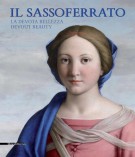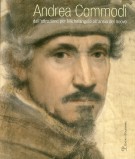Il Sassoferrato La devota bellezza Devout Beauty
| Autore/i | François Macé de Lépinay | ||
| Editore | Silvana Editoriale | Luogo | Milano |
| Anno | 2017 | Pagine | 304 |
| Dimensioni | 24x29 (cm) | Illustrazioni | 150 ill. colori e b/n n.t. - colors and b/w ills |
| Legatura | bross. ill. colori con alette - paperback | Conservazione | Nuovo - New |
| Lingua | Italiano/Inglese - Italian/English text | Peso | 2300 (gr) |
| ISBN | 8836637574 | EAN-13 | 9788836637577 |
momentaneamente non disponibile
Sassoferrato (An), Palazzo degli Scalzi, 17 giugno - 5 novembre 2017.
Dal disegno all’opera compiuta: con la sapiente guida di François Macé de Lépinay, è possibile per la prima volta ricostruire il percorso creativo di Giovan Battista Salvi, detto il Sassoferrato, che nella Roma barocca visse lontano dai clamori del mondo dell’arte, lavorando con la lena di un artigiano dedito soprattutto alla realizzazione di immagini di devozione che gli valsero il titolo di Pictor Virginum.
I saggi contenuti nel volume consentono di conoscere come l’artista abbia conseguito il suo stile inconfondibile – muovendo dal contesto locale per poi approdare nell’Urbe, dove fu a contatto con Domenichino –, quali furono i committenti che si avvalsero del suo pennello e quale influsso le sue opere abbiano avuto nel corso del XIX secolo sugli esponenti del Purismo e sui Nazareni.
Ne emerge l’immagine di un artista che con straordinaria coerenza fece propria la lezione di Raffaello per conseguire quella idealizzazione che anche nei rari ritratti si esprime attraverso una stesura pittorica meditata e attenta, ben evidente già negli studi preparatori, estranea tanto alla teatralità barocca quanto al naturalismo caravaggesco.
Sassoferrato (An), Palazzo degli Scalzi, June 17 - November 5 2017.
From the drawing to the finished work. Under the learned guidance of François Macé de Lépinay, it is now possible for the first time to reconstruct the creative trajectory of Giovan Battista Salvi, known as Sassoferrato. Living in the Rome of the baroque era but far away from the tumult of the art world, he worked with the spirit of a craftsman intent above all on creating the devotional images that earned him the title of pictor virginum.
The studies presented here shed light on how Sassoferrato developed his unmistakable style, starting on the local scene and then moving to the Eternal City, where he was in close contact with Domenichino, on the patrons he served with his brush, and on the influence of his work in the 19th century on the Purists and Nazarenes.
The resulting image is of an artist who followed the example of Raphael with extraordinary consistency to attain the idealization expressed even in his few portraits through a carefully studied approach, already clearly evident in the preparatory studies, as far removed from baroque theatricality as it is from Caravaggesque naturalism. (T-CA)
Potrebbero interessarti anche...










